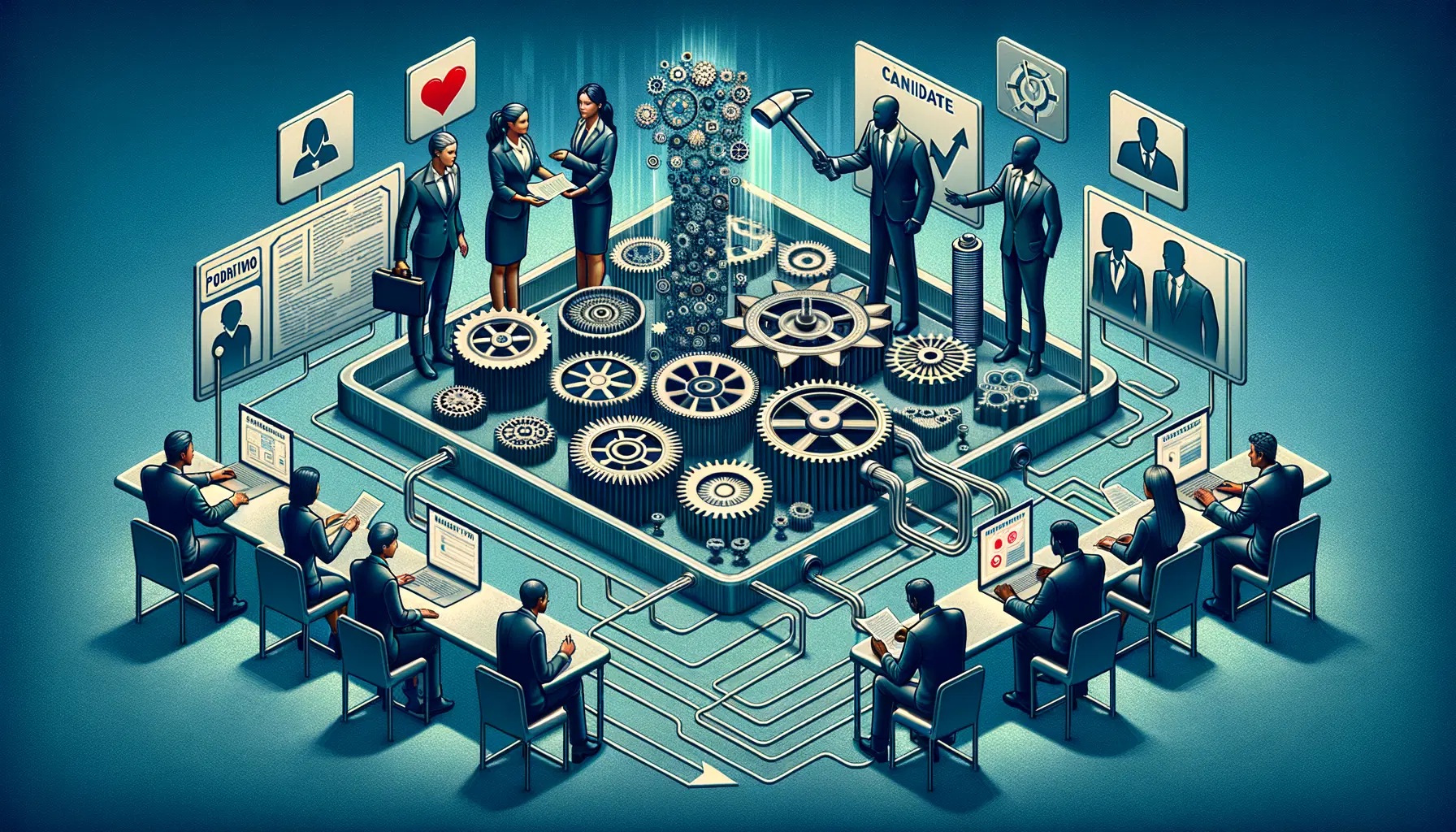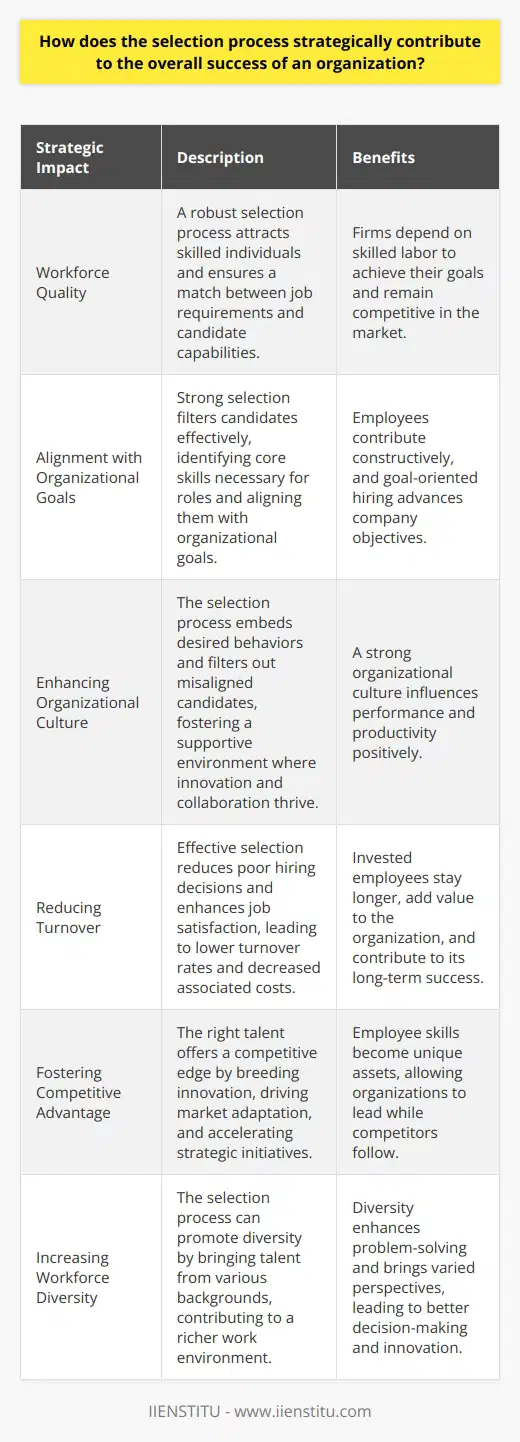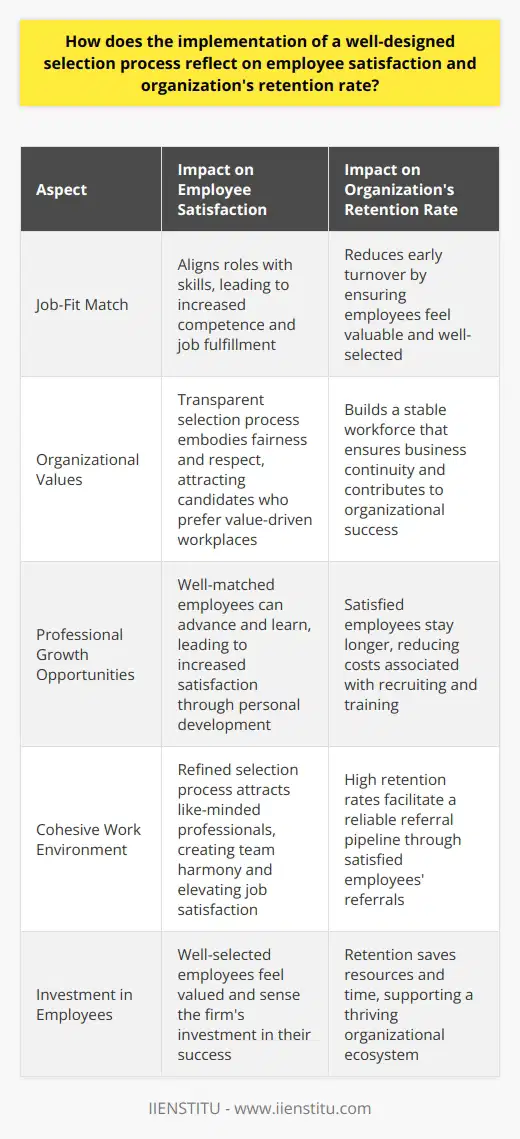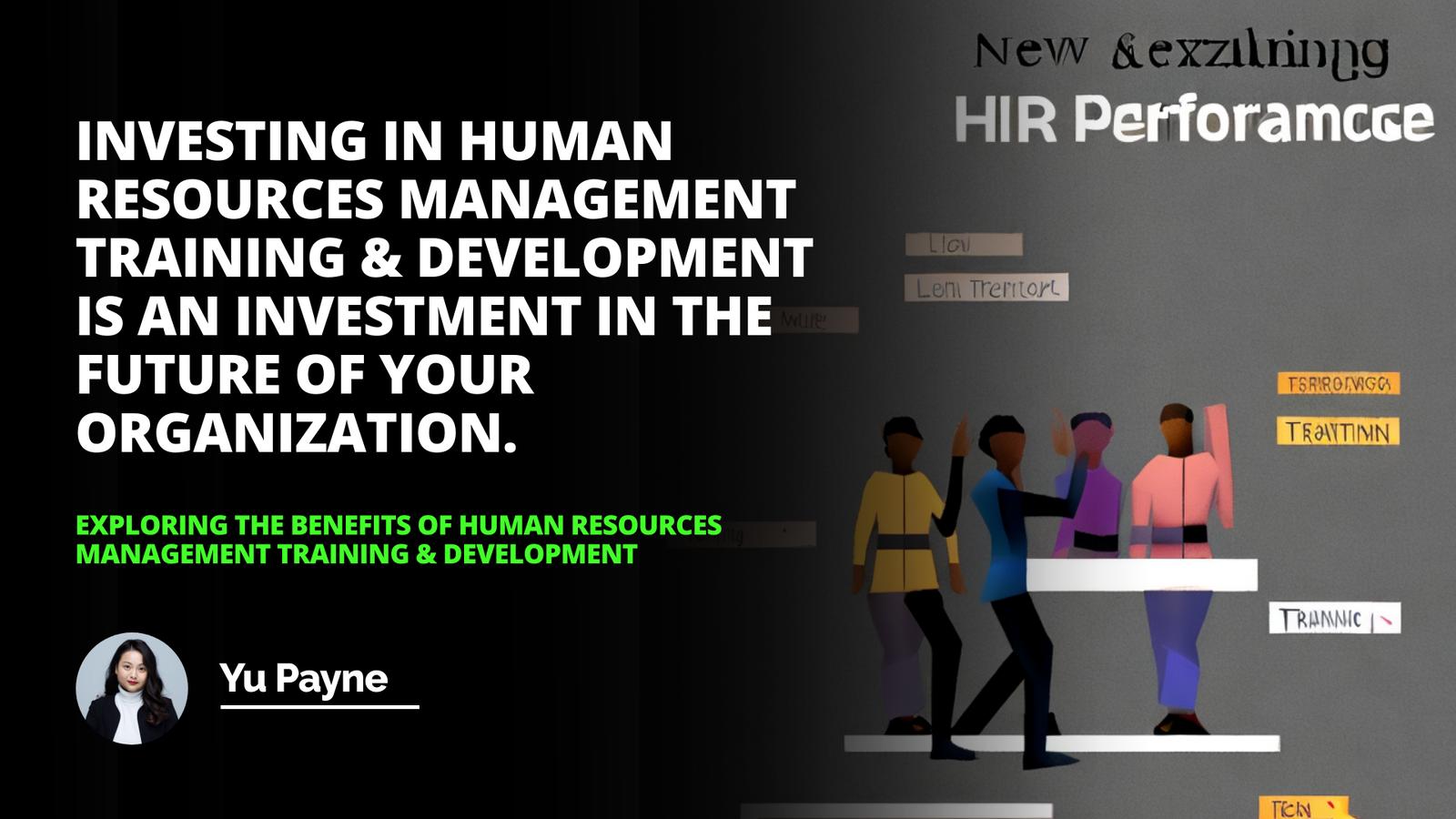
The selection process represents a critical juncture in the recruitment and human resources management cycle. In essence, it involves a series of steps where employers identify, evaluate and decide which candidates are most suitable to fill open positions within their organizations. The stakes are high; a well-executed selection process can lead to the onboarding of a highly capable and culturally aligned workforce, whereas a flawed process can result in costly hiring mistakes.
Effective selection is not just about matching skills with job requirements, but also about strategic alignment and the fostering of a positive work environment that supports organizational goals. Recognizing the strategic importance of this process allows companies to achieve competitive advantages and maintain operational excellence.
The Essence of Selection Process
The selection process is a foundational component that aligns the human capital acquisition with the strategic objectives of an organization. When executed proficiently, it ensures that the right individuals—those who possess the necessary skills, knowledge, and cultural fit—are chosen to contribute to the collective goals of the enterprise. Not only does the selection process sift through the qualifications of candidates, but it also has a broader impact on shaping the organizational culture and future success.
An effective selection process can significantly impact an organization's journey towards achieving its long-term objectives. By systematically identifying and hiring individuals whose values align with those of the company, employers facilitate a more productive and engaged workforce. When employees fit well within the company culture and possess the requisite skills and attitude, they are more likely to perform effectively and stay with the organization long-term, thus reducing turnover rates and associated costs.
Practical examples of successful selection processes are abundant across different industries. For instance, technology firms often incorporate technical assessments and problem-solving exercises into their selection process to ensure candidates have the requisite hard skills. The hospitality industry, on the other hand, may place a greater emphasis on personality assessments and team interaction exercises to ensure candidates possess the customer service ethos required for success in a service-oriented space. These examples highlight not only the diversity of selection mechanisms but also the tailored approach businesses must take to secure the right talent.
Steps in Effective Selection Process
Identifying the selection criteria
A pivotal first step in any selection process is defining the selection criteria. This includes developing clear and detailed job descriptions and specifications that outline the roles’ responsibilities, necessary skills, qualifications, and experiences. These criteria act as the bedrock upon which all candidates are evaluated, ensuring a consistent and focused recruitment effort. Moreover, it is these carefully defined specifications that set the foundation for a successful alignment between the candidate's capabilities and the organization's needs.
The significance of outlining essential skills, qualifications, and experience cannot be overstated. These criteria not only serve as a filter to identify the most suitable candidates but also assist HR professionals in maintaining objectivity throughout the selection process. Furthermore, they are instrumental in guiding the development of assessment tools and interview questions, which inherently ties back to the efficiency and effectiveness of the entire process.
Conducting pre-interview screening
Once the selection criteria are established, pre-interview screening serves as an efficient way to narrow down the pool of applicants. Methods such as reviewing resumes and cover letters, conducting telephone screens, or using applicant tracking systems to filter candidates based on specific keywords or criteria are common. Each of these methods plays a crucial role in identifying the individuals who are most likely to succeed in the later stages of the selection process.
Selecting the appropriate pre-interview screening method can save substantial time and resources. The method selected should be consistent with the job's requirements and the organization's culture. For example, a creative industry might employ portfolio reviews as a pre-interview screen to assess candidates’ previous work, while roles in a hr certificate course might prioritize different criteria, such as specific HR-related skills or knowledge obtained from online courses.
Conducting the actual interviews
Interviews are often the core of the selection process, serving as a critical medium to assess candidates’ skills, experience, cultural fit, and potential. There are various types of interviews, including behavioral, situational, panel, and competency-based interviews, each designed to evaluate different aspects of the candidate's fit for the position. The key to conducting effective interviews lies in thorough preparation, articulating clear questions, active listening, and impartial evaluation.
Different types of interviews serve distinct purposes. Behavioral interviews focus on past performance as an indicator of future behavior, while situational interviews evaluate a candidate's problem-solving capabilities in hypothetical situations. The strategic deployment of these various interview types is central to extracting relevant information that informs the final decision-making process.
Decision making and job offer
Following the interviews, decision making is a delicate balancing act involving multiple factors, such as skill set compatibility, potential for career growth, and the candidate's congruence with the organizational culture. This phase requires careful consideration and collaboration among hiring managers, HR professionals, and oftentimes, departmental teams.
The final step includes extending the job offer to the selected candidate and appropriately communicating with those who were not chosen. It is pivotal to handle job offers and rejections with professionalism and sensitivity, thereby maintaining a positive reputation for the company and paving the way for future hiring engagements.
Importance of a Fair Selection Process
The legal aspect of the selection process is crucial and requires rigorous adherence to employment laws which aim to prevent discrimination and ensure equal opportunity. Companies must foster an environment that complies with these regulations, thus avoiding legal complications that can arise from unfair or biased hiring practices. A fair selection process not only meets legal standards but also sends a strong message about the company's values and commitment to ethical practices.
A fair selection process is not only legally mandated but also has intrinsic benefits for the company. It contributes to a diverse workforce, fostering innovation, productivity, and an inclusive work environment. When employees feel respected and valued, regardless of their background, they are more engaged and committed to their roles. This, in turn, enhances the employer's brand and attracts high-caliber talent.
Legal challenges in the selection process can arise from various situations, such as unconscious bias, inconsistency in applying selection criteria, or improper documentation of the hiring process. Examples of such challenges include discrimination claims or disputes over the fairness of the process. Mitigating these legal risks requires trained HR professionals, clear policies, and continuous monitoring and improvement of hiring practices.
Challenges in Selection Process
Despite best efforts, challenges in the selection process often arise. Common errors may include relying too heavily on interviews without considering other assessment methods, unconscious bias affecting decision making, or failing to accurately define job criteria, to name a few. These challenges can lead to suboptimal hiring decisions, employee turnover, and adverse legal and organizational outcomes.
Overcoming these challenges often involves a multifaceted strategy. Implementing structured interviews, using data-driven assessment tools, and providing training on unconscious bias are some strategies to improve the selection process. Additionally, leveraging technology such as artificial intelligence and machine learning can assist in reducing human error and increasing the objectivity and efficiency of the selection process.
In summary, the selection process is a business-critical function, essential for the acquisition of talent that drives organizational success. It is a finely tuned blend of strategic planning, legal compliance, and human insight. From the meticulous crafting of job criteria to the final decision and job offer, each step demands conscious effort, equitable practice, and strategic alignment with the company's overarching goals.
An effective selection process harnesses the potential of the most valuable asset in any business—the people. The benefits of this process resonate through the entire organization, making its strategic importance unquestionably profound. With the inherent challenges acknowledged, continuous evolution and improvement in the selection process remain key to maintaining a robust, dynamic, and competitive workforce, ready to meet the demands of an ever-changing work environment.
Frequently Asked Questions
What are the crucial components involved in an effective selection process in human resource management?
The Essence of a Strategic Selection Process
Understand Organizational Needs
Every effective selection process begins with clarity. Organizations must know what they need. This understanding allows them to define job specifications precisely. They also focus on identifying the required skills, knowledge, and abilities. These are the competencies crucial for success in the role.
Job Descriptions and Person Specifications
A well-crafted job description forms the foundation. It outlines key responsibilities and job duties. A person specification complements this. It details the necessary qualifications and attributes. Together, these documents guide the selection criteria.
Sourcing Strategies
Attracting a suitable applicant pool requires smart sourcing. Employers must consider both internal and external candidates. They use job postings, employee referrals, and social media. Networking and headhunting can enrich this mix.
Application Screening
Initial screening takes center stage here. Employers review resumes and cover letters. They shortlist only the best. Technology can assist, but human judgment remains paramount.
Testing Competencies
Selecting the right candidates involves multiple assessments. These can include:
- Job-related skills tests
- Psychological tests
- Personality assessments
Tests should be valid, reliable, and relevant to the job at hand.
Interviews - A Critical Tool
Interviews allow for face-to-face interactions. Employers seek evidence of competencies. They use structured or unstructured formats. Behavioral questions can predict future performance.
Background Checks
Background checks verify an applicant's history. They ensure the accuracy of information provided. Reference checks also give insights into past performance.
Decision Making
Decision making relies on gathering and analyzing information. Employers must compare candidates against the criteria set out. They take a holistic view of each candidate's fit.
Offer of Employment
Making the offer is a delicate phase. Employers must handle it with care. They provide a competitive package. They communicate it effectively.
Onboarding
An effective selection process culminates in onboarding. New hires need support to integrate successfully. A structured onboarding program is key for retention.
Continuous Improvement
Finally, organizations must keep refining their selection processes. Feedback informs this. It closes the loop, allowing for enhancements in future hiring cycles.
In conclusion, human resource management follows these critical components to develop an effective selection process. The end goal is to match the right individual with the right job. This aids in building a workforce capable of achieving organizational goals.

How does the selection process strategically contribute to the overall success of an organization?
The Strategic Impact of the Selection Process
The selection process stands crucial to an organization's triumph. It defines the workforce quality. Firms depend on skilled labour. A robust selection process attracts these individuals. It ensures a match between job requirements and candidate capabilities.
Aligning Skills and Organizational Goals
Strong selection filters candidates effectively. It identifies core skills necessary for roles. Alignment with organizational goals follows. Employees thus contribute constructively. Furthermore, goal-oriented hiring advances company objectives.
Enhancing Organizational Culture
Culture influences performance. The selection process embeds desired behaviors. It filters out misaligned candidates. Thus, it fosters a supportive environment. Within, innovation and collaboration thrive. Productivity, therefore, benefits.
Reducing Turnover
Turnover costs organizations significantly. Effective selection reduces poor hiring decisions. It enhances job satisfaction. This translates into lower turnover rates. And decreased associated costs. Invested employees stay longer. They add value.
Fostering Competitive Advantage
The right talent offers competitive edge. It breeds innovation. It drives market adaptation. And it accelerates strategic initiatives. Employee skills become unique assets. Organizations lead, competitors follow.
Increasing Workforce Diversity
Diversity enhances problem-solving. It brings varied perspectives. The selection process can promote this diversity. It brings talent from various backgrounds. And it contributes to a richer work environment.
To summarize, the selection process underpins organizational success. It aligns talent with goals. Enhances culture. Reduces costly turnover. And secures competitive advantage. It champions diversity. Thus, it is not merely a function. It is a strategic imperative.

How does the implementation of a well-designed selection process reflect on employee satisfaction and organization's retention rate?
A Well-Designed Selection Process
Reflects on Employee Satisfaction
A robust selection process goes beyond screening. It ensures a job-fit match. This match increases employee satisfaction. Satisfaction stems from aligning roles with skills. Well-matched employees feel competent. They often experience job fulfillment. Content employees are less likely to leave. Turnover thus decreases.
Selection processes showcase organizational values. Transparent selection sends a positive signal. It embodies fairness and respect. Candidates appreciate these traits. They often prefer value-driven workplaces.
Professional growth opportunities arise from good matches. Employees can advance and learn. Satisfaction grows with personal development. Growth and satisfaction are interlinked.
Colleagues also influence satisfaction. A refined selection process attracts like-minded professionals. This creates a cohesive work environment. Team harmony elevates job satisfaction.
Impacts Organization's Retention Rate
Retention reflects job satisfaction. Satisfied employees stay longer. A precise selection process mitigates early turnover. Employees feel valuable when well-selected. They sense the firm's investment.
Turnover is costly for organizations. Direct costs relate to recruiting and training. Indirect costs involve lost knowledge. A well-designed process reduces these costs. Retention saves resources and time.
Retention builds a stable workforce. A stable workforce ensures business continuity. Continuity contributes to organizational success.
Employee referrals come from satisfied employees. Referral programs harness this potential. High retention rates facilitate a reliable referral pipeline.
In summary, a well-designed selection process benefits all. It enhances employee satisfaction and boosts retention. Such a process is an essential investment. It supports a thriving organizational ecosystem.



